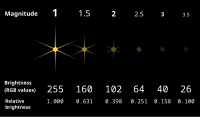Magnitude (astronomy)

Imagine you have a bunch of stars in the sky. Some stars are very bright, while others are very dim. Magnitude is how astronomers measure the brightness of these stars.
To understand magnitude, it's like a star's report card. The brightest star gets an A+, while the dimmest star gets an F. But it's not that simple.
The ancient Greeks created a system where they classified stars into six different magnitudes, with the first magnitude being the brightest and the sixth magnitude being the dimmest. Later on, astronomers realized that some stars were brighter than the first magnitude stars, so they added negative numbers to the scale.
So now, a star with a magnitude of 0 is about 2.5 times brighter than a star with a magnitude of 1, which is 2.5 times brighter than a star with a magnitude of 2, and so on.
For example, the star Sirius is one of the brightest stars in the sky and has a magnitude of -1.46, making it much brighter than the star Polaris, which has a magnitude of 1.97.
So in short, magnitude is a way to measure how bright a star is, with lower numbers being brighter and negative numbers being even brighter.
To understand magnitude, it's like a star's report card. The brightest star gets an A+, while the dimmest star gets an F. But it's not that simple.
The ancient Greeks created a system where they classified stars into six different magnitudes, with the first magnitude being the brightest and the sixth magnitude being the dimmest. Later on, astronomers realized that some stars were brighter than the first magnitude stars, so they added negative numbers to the scale.
So now, a star with a magnitude of 0 is about 2.5 times brighter than a star with a magnitude of 1, which is 2.5 times brighter than a star with a magnitude of 2, and so on.
For example, the star Sirius is one of the brightest stars in the sky and has a magnitude of -1.46, making it much brighter than the star Polaris, which has a magnitude of 1.97.
So in short, magnitude is a way to measure how bright a star is, with lower numbers being brighter and negative numbers being even brighter.
Related topics others have asked about:
